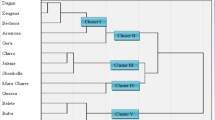Summary
This paper reports results of a 3-year evaluation of CIP advanced potato clones in a bacterial wilt-infested field (race 3) in Peru. Clones resistant or moderately resistant to wilt were selected and all tubers harvested from each clone were tested for latent infection byRalstonia solanacearum using a sensitive serological technique developed at CIP. A sampling strategy to estimate accurately the frequency of infected tubers in the clones has been evaluated. This method will allow consideration of tuber latent infection as a new selection criterion in breeding for resistance to bacterial wilt. Thirteen clones were found resistant to wilt in all three evaluations (i.e.≤6% wilt), from which five had no wilt in all trials. However, all clones harboured latent infection in tubers averaging 30%. Analysing 30 tubers/clone provides an accurate estimation of the proportion of infected tubers with a high precision level.
Similar content being viewed by others
References
Anguiz, R.J. & H.A. Mendoza, 1997. General and specific combining abilities for resistance to bacterial wilt (Pseudomonas solanacearum E.F. Smith) in PVX and PVY immune autotetraploid potatoes.Fitopatologia 32: 71–80.
Anonymous, 1989. SAS/STAT User's Guide, Version 6 Fourth Edition, Volum 1. SAS Institute Inc., Cary, NC, 43 p.
Ciampi, L. & L. Sequeira, 1980. Multiplication ofPseudomonas solanacearum in resistant potato plants and the establishment of latent infections.American Potato Journal 57: 319–329.
Ciampi, L., L. Sequeira & E.R. French, 1980. Latent infection of potato tubers byPseudomonas solanacearum.American Potato Journal 57: 377–386.
Elphinstone, J.G., J. Hennessy, J.K. Wilson & D.E. Stead, 1996. Sensitivity of different methods for the detection ofPseudomonas solanacearum (Smith) in potato tuber extracts.EPPO/OEPP Bulletin 26: 663–678.
French, E.R. & L. de Lindo, 1982. Resistance toPseudomonas solanacearum potato: Strain specificity and temperature sensitivity.Phytopathology 72: 1408–1412.
French, E.R., 1994. Strategies for integrated control, of bacterial wilt of potatoes. In: A.C. Hayward & G.L. Hartman (Eds), Bacterial wilt: The disease and its causative agent,Pseudomonas solanacearum. CAB International, Wallingford, UK, pp. 199–207.
French, E.R., L. Gutarra, P. Aley & J. Elphinstone, 1995. Culture media forPseudomonas solanacearum: Isolation, identification and maintenance.Fitopatologia 30: 126–130.
French, E.R., R. Anguiz & P. Aley, 1998. The usefulness of potato resistance toRalstonia solanacearum, for the integrated control of bacterial wilt. In: P. Prior, C. Allen & J. Elphinstone (Eds), Bacterial wilt disease: Molecular and ecological aspects. INRA Edition. Springer Verlag, Berlin, Germany, pp. 381–385.
Grimsley, N. & J.-F. Wang, 1994. Chair's perspective: Host resistance. In: A.C. Hayward & G.L. Hartman (Eds), Bacterial wilt: The disease and its causative agent,Pseudomonas solanacearum. CAB International, Wallingford, UK, pp. 197–199.
Kloos J.P. & B.B. Fernandez, 1986. Evaluation of potato germplasm for resistance toPseudomonas solanacearum (E.F. Smith) and adaptation in Mindanao.The Philippine Agriculturist 69: 263–276.
Opina, N., F. Taver, G. Hollway, J.F. Wang, T.H. Li, R. Maghirang, M. Fegan, A.C. Hayward, V. Krishnapllai, W.F. Hong, B.W. Holloway & J.N. Timmis, 1997. A novel method for development of species and strain-specific DNA probes and PCR primers for identifyingBurkholderia solanacearum (formerlyPseudomonas solanacearum).Asia Pacific Journal of Molecular Biology and Biotechnology 5: 19–30.
Prior, P., V. Grimault & J. Schmit, 1994. Resistance to bacterial wilt (Pseudomonas solanacearum) in tomato: Present status and prospects. In: A.C. Hayward & G.L. Hartman (Eds), Bacterial wilt: The disease and its causative agent,Pseudomonas solanacearum. CAB International, Wallingford, UK, pp. 209–223.
Priou, S., L. Gutarra & P. Aley, 1999a. Highly sensitive detection ofRalstonia solanacearum in latently infected potato tubers by post-enrichment ELISA on nitrocellulose membrane.EPPO/OEPP Bulletin 29: 117–125.
Priou, S., L. Gutarra, H. Fernandez & P. Aley, 1999b. Sensitive detection ofRalstonia solanacearum in latently infected potato tubers and soil by post-enrichment ELISA. Impact on a changing world. Program report 1997-98. International Potato Center, Lima, Peru, pp. 111–121.
Priou, S., P. Aley, E. Chujoy, B. Lemaga & E.R. French, 1999c. CIP Series IV–III, Integrated control of bacterial wilt of potato. CIP slide training series (57 slides and a 30 pages-guide in English and Spanish). International Potato Center, Lima, Peru.
Schmiediche, P., 1985. Breeding potatoes for resistance to bacterial wilt caused byPseudomonas solanacearum. In: G.J. Persley (Ed.), ACIAR Proceedings no. 13. Canberra, Australia, pp. 105–111.
Schmiediche, P. & C. Martin, 1986. The use of wild species in breeding for resistance to bacterial wilt (Pseudomonas solanacearum).American Potato Journal 63: 453.
Sequeira, L. & P.R. Rowe, 1969. Selection and utilization ofSolanum phureja clones with high resistance to different strains ofPseudomonas solanacearum.American Potato Journal 46: 451–462.
Thurston, H.D. & J.C. Lozano, 1968. Resistance to bacterial wilt of potatoes in Colombian clones ofSolanum phureja.American Potato Journal 45: 51–55.
Tung, P.X. & P. Schmiediche, 1995. Breeding potato for resistance to bacterial wilt (Pseudomonas solanacearum): Looking for stable resistance? In: B. Hardy & E.R. French (Eds), Integrated management of bacterial wilt. Proceedings of the international workshop, Indian Council of Agricultural Research, New Delhi (India) and International Potato Center (CIP), Lima, Peru, pp. 173–176.
Weller, S.A., J.G. Elphinstone, N.C. Smith & D.E. Stead, 2000. Detection ofRalstonia solanacearum from potato tissue by post-enrichment TaqMan PCR.EPPO/OEPP Bulletin 30: 81–383.
Author information
Authors and Affiliations
Rights and permissions
About this article
Cite this article
Priou, S., Salas, C., De Mendiburu, F. et al. Assessment of latent infection frequency in progeny tubers of advanced potatoclones resistant to bacterial wilt: A new selection criterion. Potato Res 44, 359–373 (2001). https://doi.org/10.1007/BF02358596
Accepted:
Issue Date:
DOI: https://doi.org/10.1007/BF02358596




